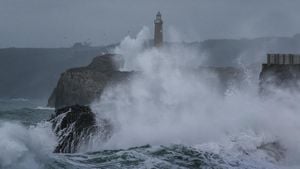Wildfires have ignited across the Northeast, thrusting roughly 27 million residents from New York to Massachusetts under urgent fire alerts. On Saturday afternoon, major cities like New York City and Boston found themselves grappling with the worsening situation as wind gusts reached up to 35 mph and humidity levels plummeted to about 25% to 30%. These dry conditions have not only heightened the risk of blazes but also hampered firefighting efforts.
Compounding the issue, the region has suffered significant rainfall deficits, with reports indicating it lags behind by 6 to 8 inches since September 1. Such dry spells, combined with the sweeping winds, create a perilous mix for potential fire outbreaks. National authorities are sounding the alarm, stressing the importance of vigilance and preparedness among residents.
The weather has played both sides—a cold front is expected to sweep through the affected areas, but not before it potentially fans the flames. Emergency responders are on high alert as they confront the rapidly changing conditions. Officials advise residents to prep for possible evacuations or to have emergency plans ready should the fire situation deteriorate.
Across New Jersey, flames from wildfires have already forced evacuations, highlighting the urgent nature of this environmental crisis. Residents near fire-prone zones are reporting their actions based on warnings from local authorities. People are heeding the advice, packing essentials and preparing to leave at a moment's notice if conditions get worse.
Meanwhile, the air quality index has dropped alarmingly, prompting health advisories for sensitive groups. The acrid smell of smoke fills the air, serving as a constant reminder of the unrest caused by the wildfires. Communities are encouraged to stay indoors, with the advice to keep windows shut and to use air conditioning if available.
Fire departments are working tirelessly, but access challenges, such as rough terrain and high winds, impede their progress. The deployment of aerial resources is increasingly important, as these units can cover ground quickly and drop water on hard-to-reach flames. Wildfire management teams have focused their efforts on containment strategies, relying on bulldozers and controlled burns as part of their tactical response.
Yet, with fire seasons intensifying due to climate variability, the challenges facing firefighting operations are mounting. Some experts warn this could represent the new normal, where dry spells and increased wind patterns become commonplace. This contest against nature directly affects local economies, tourism, and even moods of the surrounding communities, some of whom have already faced hardships due to the pandemic and other social constraints.
Shared concerns about the climate crisis echo throughout the region, as residents note strange weather patterns and uncharacteristically severe fire seasons. Community meetings are sprouting up, aiming to educate citizens on developing fire safety protocols. Group initiatives discuss the creation of firebreaks and the restoration of natural fire-resistant landscapes, hoping to adapt to their increasingly precarious environment.
Experts also recommend engaging with local representatives to push for significant policy changes. The links between climate patterns and wildfires become clearer, with many scientists urging for proactive approaches to mitigate future fire risks. During these discussions, studies reveal insights about the patterns of wildfire activity, expert advisory recommendations, and community resilience strategies.
Fire alerts are expected to remain active as long as the weather remains volatile. Authorities continue to monitor conditions closely and provide regular updates on fire risks. The call for collective action resonates—people are reminded of their power to maintain their safety and well-being, rallying together against the chaos of wildfires.
This season has shown just how fragile the balance of nature can be. While the immediate focus is on the wildfires, there’s also introspection about long-term environmental health and climate strategy. Community engagement is at the forefront, as education on safety and proactive steps can significantly mitigate disaster risks.
With many still reeling from prior natural calamities, the Northeast faces yet another challenge. The fires devastate habitats and disrupt lives, but they also galvanize gatekeeping conversations about sustainable practices and community mutual support. Residents should not only brace for dangers present but actively engage to shape the future they wish to see.



